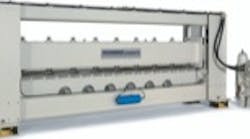This non-woven fabric cutting machine relies on electrohydraulics for high speed, high force performance while achieving positioning accuracy to 1 µm.
Speed and absolute positioning accuracy are the decisive factors when it comes to the production and processing of non-woven fabrics. To ensure success when they were developing a new cutting machine, Gerold Fleissner Nonwovens GmbH & Co., Ansbach, Germany, called on the electrohydraulics expertise of Bosch Rexroth, Lohr, Germany.
Although most people frequently encounter non-woven fabric, it largely goes unnoticed. Non-woven fabric is used in loudspeakers, air-conditioners, dehumidifiers, range hoods, toys, sail boats, quilted jackets and shoulder pads, and numerous others. Ever-increasing demand has caused manufacturers of non-woven fabric processing machinery to increase production rates without sacrificing precision. Because the material is manufactured in a continuous process, rather than in batches, scheduled downtime for maintenance and readjustment is rare.
Establishing requirements
High cutting frequencies with variable strokes and material widths and tight positioning accuracy are musts to ensure high quality and productivity. Many manufacturers meet this challenge with hydraulics because of its combined capabilities of high speed, force, and precision. Fleissner engineers needed an intelligent drive for a newly developed machine to cross-cut and perforate non-woven fabric. The drive had to transmit vibration-free motion to traverse a knife over an operating width to 2 to 7.5 m. Furthermore, elevation of the knife had to be variable through a maximum height of 250 mm with a positioning accuracy of ± 0.05 mm. All this had to be achieved within 0.5 sec or less per double stroke — requiring speeds to 0.8 m/sec.
The electrohydraulic solution
Experts at Bosch Rexroth came up with an electrohydraulic solution after running simulations of the operation. Two modified standard differential cylinders with low-friction seals and integrated position measuring system can achieve positioning accuracy of 1 µm.
Because peak cylinder speeds reach 0.8 m/sec, the high flows required to direct hydraulic fluid into and out of the cylinder presented a challenge. Engineers came up with a simple solution: two ports at each end of the cylinder instead of only one. This allows twice the flow rate through the cylinder without causing too high a pressure differential.
Cylinders also incorporate a mechanism to prevent cylinder drift when the control is switched off.
Valves with integrated electronics are assembled onto each cylinder assembly. Placing the valve as close as possible to the cylinder improves system dynamics by minimizing the effects of fluid compressibility between the valve and cylinder.
Positioning, pressure and synchronization functions are accomplished through a dual-axis digital controller, Bosch Rexroth's HNC 100. The controller's CNC programmability enables the complete movement sequences to be stored in its closed loop control electronics. The signal interchange is effected via a Profibus DPL2 connection between the HNC and master machine control.
The hydraulic power unit was built from modular standard assemblies. A pressure-compensated axial-piston pump accommodates maximum operating pressure to 210 bar. A 32-l bladder-type accumulator supplements pump flow during peak flow demands. This supplemental flow from the accumulator allows sizing the pump closer to average flow, rather than to peak flow. Therefore, a smaller, more energy-efficient pump can be specified. In this case, the peak (corner) power requirement was reduced almost by half — from 34 kW to 18.5 kW.
Rounding out the power unit package is an offline cooling and filtration (kidney) loop. A circulating pump continuously draws fluid from the reservoir and routes it through a filter and heat exchanger.
The off-line filter protects sensitive valves and other components from being damaged by contamination. Because the kidney loop is not part of the hydraulic drive circuit, filter elements can be changed without affecting operation of the overall machine.
Heat generated by the system can cause rapid and serious degradation of the oil, so the heat exchanger keeps the fluid temperature within a prescribed range. After exiting the heat exchanger, fluid flows back into the reservoir.
Requirements exceeded
With this configuration Gerold Fleissner Nonwovens is able to offer a high-precision cutting machine that is unmatched in terms of its cutting dimension capability of nonwoven fabrics. Advancements such as this may ensure that we will soon be encountering non-woven fabrics in even more aspects of our lives.
For more information, contact Bosch Rexroth at www.boschrexroth.com.


